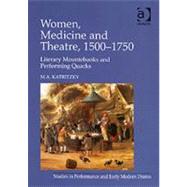Women, Medicine and Theatre 1500û1750: Literary Mountebanks and Performing Quacks
, by Katritzky,M.A.- ISBN: 9780754650843 | 0754650847
- Cover: Hardcover
- Copyright: 9/28/2007
Katritzky''s main focus is on plays and players, but her assiduous research has assembled as much as could be hoped for on the extremely elusive presence of women in early modern performative medicine. Her detailed study provides a storehouse of invaluable information, as well as decisive interventions in debates over the nature of early modern theatre.''Margaret Pelling, Reader in Social History of Medicine, University of OxfordDrawing on a comprehensive range of early modern British, German and other European images and texts, this study offers the first interdisciplinary gendered assessment of early modern performing itinerant quacks. The contribution of women is taken as the focus for an investigation of the nature of the links between the theatrical and the medical, in the activities of quack troupes as they went about curing, selling and, above all, performing. Well illustrated, accessibly presented, and drawing on a comprehensive range of historical documents, including British, German and other European images, and literary as well as non-literary texts (many previously unconsidered in this context), this study offers the first interdisciplinary gendered assessment of early modern performing itinerant healers (mountebanks, charlatans and quacksalvers).As Katritzky shows, quacks, male or female, combined, in widely varying proportions, three elements: the medical, the itinerant and the theatrical. Above all, they were performers. They used theatricality, in its widest possible sense, to attract customers and to promote and advertise their pharmaceuticals and health care services. Katritzky investigates here the performative aspects of quack marketing and healing methods, and their profound links with the rise of Europe''s professional actresses, fields of enquiry which are only now beginning to attract significant attention from historians of medicine, economics or the theatre.Women, Medicine and Theatre also recovers women''s roles in the economy of the itinerant quack stage. Women associated with mountebank troupes were medically and theatrically active at every level from major stage celebrities to humble urine sample collectors, but also included sedentary relatives, non-performing assistants, door- and bookkeepers, wardrobe mistresses, prop and costume loaners, landladies, spectators, patrons and clients. Katritzky''s study of the whole range of women who supported the troupes contextualizes the activities of their male counterparts, and rehabilitates a broad spectrum of diversely occupied women.The strength of this title''s research method lies in its comparative examination of documents that are generally examined from the point of view of either their performative or their medical aspects, by historians of, respectively, the theatre and medicine. Taken as a whole, these handbills, literary descriptions and other texts and images reveal the interactions between the main aspects of male and female quack activity: curing, selling and, above all, performing. Contents: Introduction: ''Mountebanks, monsters and several beasts'': Margaret Cavendish at the Antwerp carnival fair. Part I Performing Medieval Quacks: Quack actresses of 1514; Literary mountebanks I: sex ''n shopping on the medieval religious stage; A quack picture: a key to the appearance of medieval staging? Part II Visual Aspects of Mountebank Activity: Friendship albums and other visual sources; Containers, stages and venues; The troupe; Performative aspects. Part III Marketing Medicine: Medical and commercial activity; Women as healers; Literary mountebanks II: stage quacks of Ben Jonson, Thomas Killigrew, Aphra Behn and Christian Weise; Quack couples: the male-female partnership. Part IV Gendering Tooth-Drawers: Tooth-drawers; Literary mountebanks III: Johann Kuhnau''s female tooth-drawer, 1700; A French tooth-drawer: on the stage of Europe''s first secular theatre? Part V Commedia dell''Arte Actresses: The inamorata; Comici and buffoni; Italian mixed-gender troupe







